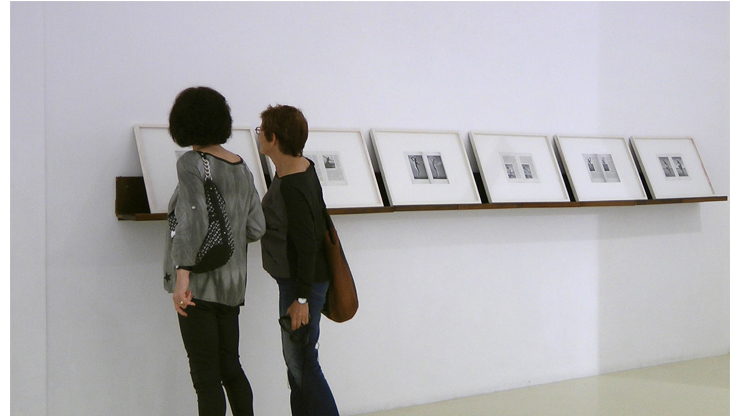Erez Israeli presents photographs from Hans Surén’s 1924 book Man and Sun (Der Mensch und die Sonne) alongside photomontage works which depict his own body imitating the postures in the book.
The six works, placed on shelves originally from a synagogue, were created during the artist’s residency in Berlin in the summer of 2013. An additional photomontage work, which is a continuation of this series, is based on a group photo from the book and was created in Israel in 2014 especially for this exhibition. Man and Sun is a Nazi propaganda book which was a bestseller in its day, selling hundreds of thousands of copies. The book calls upon members of the “Aryan race” to go out to nature and expose their marvelous bodies to the sun and to the world. It is written as an instruction manual and demonstrates, sometimes using
photos of the author himself, how to keep the Aryan body in perfect shape by exercising outdoors. The book promotes the philosophy of the Free Body Culture (Nacktkultur or Freikörperkultur) established in Germany’s large cities already at the beginning of the century to promote nudism as part of modernism.
According to this philosophy, movement and nudity embody a primeval attachment to nature on the one hand, and progress and modernity on the other. This series is a continuation of Israeli’s preoccupation with exploring emotionally charged themes through personal corporeal experiences. The artist includes photos of his body in the original posture adopted by Surén’s subjects. At first glance, it does seem as though they were photographed in the great outdoors, but the German photographer, followed by Erez Israeli, actually cut their studio photographs – the former with metal scissors and the latter using Photoshop – and then paste them over other landscape photos. According to Israeli, “In this work I try to reproduce the various postures and present my Jewish body to the world as perfectly as I can”. At second glance after the deceit has been exposed, the viewer naturally tends to compare the Aryan “original” with the Jewish “copy”. Presenting the photos upon shelves used to store holy books during countless prayers in an old synagogue, charges the works and the comparison process invited by them with an additional layer of meaning. In Boaz Neumann’s book on Nazi ideology, Space, Body, Language (2002), Nazism is described as a worldview which constituted two separate worlds, one for the Aryan German and the other for the Jew. Each of these worlds played itself out in a space where a unique body and language were created. This archival work invokes the relation between the ideological discourse and society and its members’ relationship with their bodies. Interest in the human body, a central theme throughout art history, transforms here into a prism of Nazi ideology. The artist’s choices of such a central theme in the history of art and a book so iconic in its time may be read as defying racist, as well as gendered, nationalist and esthetic ideals in general – and a protest against the denial of the Other.
Courtesy of the artist and Givon Art Gallery

Less Reading...
